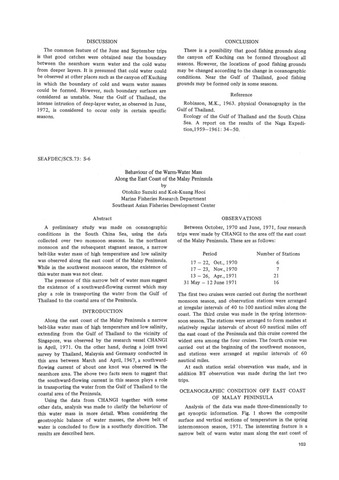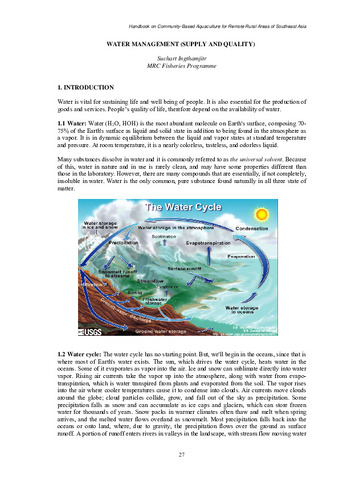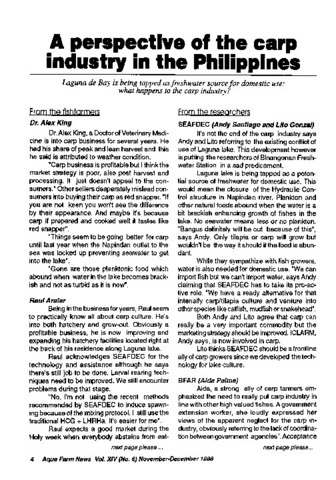Effects of UV-treated sea water, chlorinated sea water, and formalin-treated copepods on survival and growth of newborn seahorses, Hippocampus comes
Share
| dc.contributor.author | Buen-Ursua, Shelah Mae A. | |
| dc.contributor.author | Azuma, Teruo | |
| dc.contributor.author | Recente, Charlemagne P. | |
| dc.contributor.author | Batatin, Ronald E. | |
| dc.date.accessioned | 2014-05-30T07:23:59Z | |
| dc.date.available | 2014-05-30T07:23:59Z | |
| dc.date.issued | 2011 | |
| dc.identifier.citation | Buen-Ursua, S. M. A., Azuma, T., Recente, C. P., & Batatin, R. E. (2011). Effects of UV-treated sea water, chlorinated sea water, and formalin-treated copepods on survival and growth of newborn seahorses, Hippocampus comes. The Israeli Journal of Aquaculture-Bamidgeh, 63, 7 pp. | en |
| dc.identifier.issn | 0792-156X | |
| dc.identifier.uri | http://hdl.handle.net/10862/2112 | |
| dc.description.abstract | Seed production of the seahorse Hippocampus comes was examined using different types of sea water (UV-treated, chlorinated, sand-filtered), and formalin-treated copepod Pseudodiaptomous sp. as a food organism. Growth and survival of newborn seahorses (8.9±0.0 mm stretched height, 0.004 g) were monitored until day 30 after birth. Growth (stretched height and weight) was significantly higher (p<0.05) in UV-treated sea water (41.4±0.5 mm, 0.23±0.00 g) than in chlorinated (33.8±1.4 mm, 0.16±0.00 g) or sand-filtered (32.8±0.1 mm, 0.16±0.00 g) sea water. Survival was significantly higher in UV-treated (65.6±1.1%) and chlorinated (62.2±4.0%) sea water than in sand-filtered sea water (41.1±1.1%). Survival of seahorses fed 30 ppm formalin-treated copepods (95.3±1.8%) was significantly higher (p<0.05) than of seahorses fed untreated copepods (78.7±5.5%) on day 8. On day 15 survival was 78.7±9.68% in seahorses fed formalin-treated copepods and 0% in those fed untreated copepods. By day 30, survival of seahorses fed formalin-treated copepods was 64.7±9.82%. On the day of the final comparison (day 10), there was no difference in size between groups. Thus, the present study demonstrates that survival and growth of newborn seahorses is significantly improved in UV-treated water, and survival is markedly maintained by treating food organisms in formalin. | en |
| dc.description.sponsorship | The authors thank the anonymous reviewer for helpful comments and suggestions for improving the manuscript. The authors also thank Rod Salvador Tibubos and Arnel Abaricio for their assistance in the maintenance of the seahorses. This study was funded by SEAFDEC/AQD under Study Code BR-02-F2007T, Contribution No. 2011-02, and by the Government of Japan Trust Fund (GOJ-TF) Stock Enhancement Program under the project title “Resource Enhancement of Internationally Threatened and Over-Exploited Species in Southeast Asia through Stock Release”. | en |
| dc.language.iso | en | en |
| dc.publisher | Society of Israeli Aquaculture and Marine Biotechnology (SIAMB) | en |
| dc.relation.uri | http://cmsadmin.atp.co.il/Content_siamb/editor/63.2011.629.Buen-Ursua.pdf | |
| dc.subject | Seahorse | |
| dc.subject | Copepoda | en |
| dc.subject | formalin | en |
| dc.title | Effects of UV-treated sea water, chlorinated sea water, and formalin-treated copepods on survival and growth of newborn seahorses, Hippocampus comes | en |
| dc.type | Article | en |
| dc.citation.volume | 63 | |
| dc.citation.spage | 7 pp | |
| dc.citation.journalTitle | The Israeli Journal of Aquaculture-Bamidgeh | en |
| dc.subject.asfa | seed production | en |
| dc.subject.asfa | water treatment | en |
| dc.subject.asfa | survival | en |
| dc.subject.asfa | growth | en |
| dc.subject.scientificName | Hippocampus comes | en |
Files in this item
| Files | Size | Format | View |
|---|
This item appears in the following Collection(s)
-
AQD Journal Articles [1214]
These papers were contributed by AQD staff to various national and international journals



